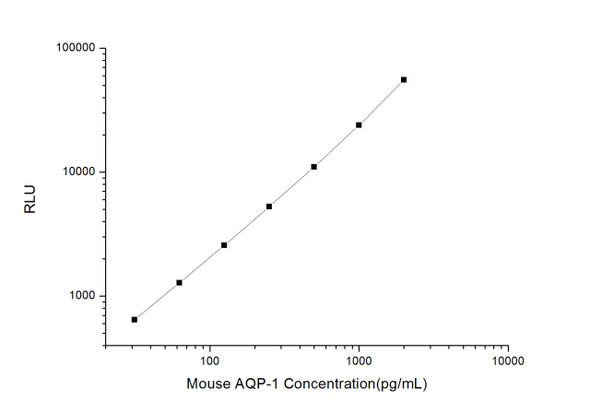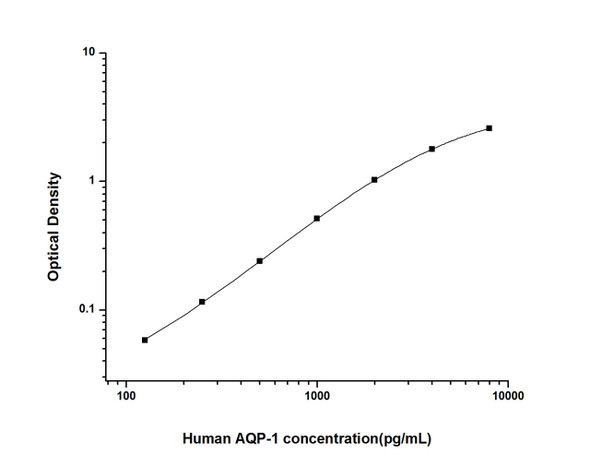Human Signal Transduction ELISA Kits
Human AQP-1 (Aquaporin 1) CLIA Kit (HUES00349)
- SKU:
- HUES00349
- Product Type:
- ELISA Kit
- ELISA Type:
- CLIA Kit
- Size:
- 96 Assays
- Sensitivity:
- 18.75pg/mL
- Range:
- 31.25-2000pg/mL
- ELISA Type:
- Sandwich
- Synonyms:
- AQP1, AQP-CHIP, CHIP28, CO
- Reactivity:
- Human
- Sample Type:
- Serum, plasma and other biological fluids
- Research Area:
- Signal Transduction
Description
| Assay type: | Sandwich |
| Format: | 96T |
| Assay time: | 4.5h |
| Reactivity: | Human |
| Detection method: | Chemiluminescence |
| Detection range: | 31.25-2000 pg/mL |
| Sensitivity: | 18.75 pg/mL |
| Sample volume: | 100µL |
| Sample type: | Serum, plasma and other biological fluids |
| Repeatability: | CV < 15% |
| Specificity: | This kit recognizes Human AQP-1 in samples. No significant cross-reactivity or interference between Human AQP-1 and analogues was observed. |
This kit uses Sandwich-CLIA as the method. The micro CLIA plate provided in this kit has been pre-coated with an antibody specific to Human AQP-1. Standards or samples are added to the appropriate micro CLIA plate wells and combined with the specific antibody. Then a biotinylated detection antibody specific for Human AQP-1 and Avidin-Horseradish Peroxidase (HRP) conjugate are added to each micro plate well successively and incubated. Free components are washed away. The substrate solution is added to each well. Only those wells that contain Human AQP-1, biotinylated detection antibody and Avidin-HRP conjugate will appear fluorescence. The Relative light unit (RLU) value is measured spectrophotometrically by the Chemiluminescence immunoassay analyzer. The RLU value is positively associated with the concentration of Human AQP-1. The concentration of Human AQP-1 in the samples can be calculated by comparing the RLU of the samples to the standard curve.
| UniProt Protein Function: | AQP1: Forms a water-specific channel that provides the plasma membranes of red cells and kidney proximal tubules with high permeability to water, thereby permitting water to move in the direction of an osmotic gradient. Belongs to the MIP/aquaporin (TC 1. A. 8) family. |
| UniProt Protein Details: | Protein type:Membrane protein, multi-pass; Membrane protein, integral; Transporter; Transporter, aquaporin family Chromosomal Location of Human Ortholog: 7p14 Cellular Component: nuclear membrane; apical part of cell; integral to plasma membrane; brush border membrane; basolateral plasma membrane; apical plasma membrane; cytoplasm; basal plasma membrane; plasma membrane; nerve terminal; nucleus; sarcolemma; brush border Molecular Function:protein binding; ephrin receptor binding; potassium channel activity; water transporter activity; intracellular cGMP activated cation channel activity; ammonium transmembrane transporter activity; glycerol transmembrane transporter activity; potassium ion transmembrane transporter activity; nitric oxide transporter activity; water channel activity; transmembrane transporter activity; glycerol channel activity Biological Process: cGMP biosynthetic process; glycerol transport; cerebrospinal fluid secretion; wound healing; cellular response to stress; water transport; carbon dioxide transport; negative regulation of caspase activity; sensory perception of pain; pancreatic juice secretion; positive regulation of saliva secretion; odontogenesis; positive regulation of fibroblast proliferation; nitric oxide transport; hyperosmotic salinity response; bicarbonate transport; multicellular organismal water homeostasis; cellular homeostasis; transmembrane transport; lipid digestion; potassium ion transport; lateral ventricle development; response to drug; cellular water homeostasis; secretory granule organization and biogenesis; glomerular filtration; ammonium transport; positive regulation of angiogenesis; renal water transport; camera-type eye morphogenesis; response to estrogen stimulus; adrenocorticotropin hormone secretion; establishment and/or maintenance of actin cytoskeleton polarity; renal water homeostasis; cell volume homeostasis; negative regulation of apoptosis Disease: Blood Group--colton |
| NCBI Summary: | Aquaporins are a family of small integral membrane proteins related to the major intrinsic protein (MIP or AQP0). This gene encodes an aquaporin which functions as a molecular water channel protein. It is a homotetramer with 6 bilayer spanning domains and N-glycosylation sites. The protein physically resembles channel proteins and is abundant in erythrocytes and renal tubes. The gene encoding this aquaporin is a possible candidate for disorders involving imbalance in ocular fluid movement. Several transcript variants encoding different isoforms have been found for this gene. [provided by RefSeq, Jun 2010] |
| UniProt Code: | P29972 |
| NCBI GenInfo Identifier: | 267412 |
| NCBI Gene ID: | 358 |
| NCBI Accession: | P29972. 3 |
| UniProt Secondary Accession: | P29972,Q8TBI5, Q8TDC1, B5BU39, E7EM69, E9PC21, F5GY19 |
| UniProt Related Accession: | P29972 |
| Molecular Weight: | 16,677 Da |
| NCBI Full Name: | Aquaporin-1 |
| NCBI Synonym Full Names: | aquaporin 1 (Colton blood group) |
| NCBI Official Symbol: | AQP1 |
| NCBI Official Synonym Symbols: | CO; CHIP28; AQP-CHIP |
| NCBI Protein Information: | aquaporin-1; aquaporin-CHIP; urine water channel; channel-like integral membrane protein, 28-kDa; water channel protein for red blood cells and kidney proximal tubule; aquaporin 1 (channel-forming integral protein, 28kDa, CO blood group) |
| UniProt Protein Name: | Aquaporin-1 |
| UniProt Synonym Protein Names: | Aquaporin-CHIP; Urine water channel; Water channel protein for red blood cells and kidney proximal tubule |
| UniProt Gene Name: | AQP1 |
| UniProt Entry Name: | AQP1_HUMAN |
As the RLU values of the standard curve may vary according to the conditions of the actual assay performance (e. g. operator, pipetting technique, washing technique or temperature effects), the operator should establish a standard curve for each test. Typical standard curve and data is provided below for reference only.
| Concentration (pg/mL) | RLU | Average | Corrected |
| 2000 | 54683 56759 | 55721 | 55693 |
| 1000 | 22147 25801 | 23974 | 23946 |
| 500 | 11500 10564 | 11032 | 11004 |
| 250 | 5170 5418 | 5294 | 5266 |
| 125 | 2702 2514 | 2608 | 2580 |
| 62.5 | 1376 1246 | 1311 | 1283 |
| 31.25 | 631 717 | 674 | 646 |
| 0 | 27 29 | 28 | -- |
Precision
Intra-assay Precision (Precision within an assay): 3 samples with low, mid range and high level Human AQP-1 were tested 20 times on one plate, respectively.
Inter-assay Precision (Precision between assays): 3 samples with low, mid range and high level Human AQP-1 were tested on 3 different plates, 20 replicates in each plate.
| Intra-assay Precision | Inter-assay Precision | |||||
| Sample | 1 | 2 | 3 | 1 | 2 | 3 |
| n | 20 | 20 | 20 | 20 | 20 | 20 |
| Mean (pg/mL) | 99.35 | 291.60 | 891.14 | 101.49 | 299.18 | 910.82 |
| Standard deviation | 12.49 | 28.11 | 56.59 | 10.82 | 30.16 | 79.24 |
| C V (%) | 12.57 | 9.64 | 6.35 | 10.66 | 10.08 | 8.70 |
Recovery
The recovery of Human AQP-1 spiked at three different levels in samples throughout the range of the assay was evaluated in various matrices.
| Sample Type | Range (%) | Average Recovery (%) |
| Serum (n=5) | 87-101 | 94 |
| EDTA plasma (n=5) | 90-101 | 95 |
| Cell culture media (n=5) | 90-105 | 98 |
Linearity
Samples were spiked with high concentrations of Human AQP-1 and diluted with Reference Standard & Sample Diluent to produce samples with values within the range of the assay.
| Serum (n=5) | EDTA plasma (n=5) | Cell culture media (n=5) | ||
| 1:2 | Range (%) | 100-114 | 85-95 | 94-107 |
| Average (%) | 108 | 90 | 101 | |
| 1:4 | Range (%) | 89-103 | 101-117 | 103-116 |
| Average (%) | 94 | 107 | 109 | |
| 1:8 | Range (%) | 97-110 | 89-105 | 96-109 |
| Average (%) | 103 | 96 | 102 | |
| 1:16 | Range (%) | 89-104 | 103-117 | 100-112 |
| Average (%) | 96 | 108 | 106 |
An unopened kit can be stored at 4°C for 1 month. If the kit is not used within 1 month, store the items separately according to the following conditions once the kit is received.
| Item | Specifications | Storage |
| Micro CLIA Plate(Dismountable) | 8 wells ×12 strips | -20°C, 6 months |
| Reference Standard | 2 vials | |
| Concentrated Biotinylated Detection Ab (100×) | 1 vial, 120 µL | |
| Concentrated HRP Conjugate (100×) | 1 vial, 120 µL | -20°C(shading light), 6 months |
| Reference Standard & Sample Diluent | 1 vial, 20 mL | 4°C, 6 months |
| Biotinylated Detection Ab Diluent | 1 vial, 14 mL | |
| HRP Conjugate Diluent | 1 vial, 14 mL | |
| Concentrated Wash Buffer (25×) | 1 vial, 30 mL | |
| Substrate Reagent A | 1 vial, 5 mL | 4°C (shading light) |
| Substrate Reagent B | 1 vial, 5 mL | 4°C (shading light) |
| Plate Sealer | 5 pieces | |
| Product Description | 1 copy | |
| Certificate of Analysis | 1 copy |
- Set standard, test sample and control (zero) wells on the pre-coated plate and record theirpositions. It is recommended to measure each standard and sample in duplicate. Note: addall solutions to the bottom of the plate wells while avoiding contact with the well walls. Ensuresolutions do not foam when adding to the wells.
- Aliquot 100µl of standard solutions into the standard wells.
- Add 100µl of Sample / Standard dilution buffer into the control (zero) well.
- Add 100µl of properly diluted sample (serum, plasma, tissue homogenates and otherbiological fluids. ) into test sample wells.
- Cover the plate with the sealer provided in the kit and incubate for 90 min at 37°C.
- Aspirate the liquid from each well, do not wash. Immediately add 100µL of BiotinylatedDetection Ab working solution to each well. Cover the plate with a plate seal and gently mix. Incubate for 1 hour at 37°C.
- Aspirate or decant the solution from the plate and add 350µL of wash buffer to each welland incubate for 1-2 minutes at room temperature. Aspirate the solution from each well andclap the plate on absorbent filter paper to dry. Repeat this process 3 times. Note: a microplatewasher can be used in this step and other wash steps.
- Add 100µL of HRP Conjugate working solution to each well. Cover with a plate seal andincubate for 30 min at 37°C.
- Aspirate or decant the solution from each well. Repeat the wash process for five times asconducted in step 7.
- Add 100µL of Substrate mixture solution to each well. Cover with a new plate seal andincubate for no more than 5 min at 37°C. Protect the plate from light.
- Determine the RLU value of each well immediately.






